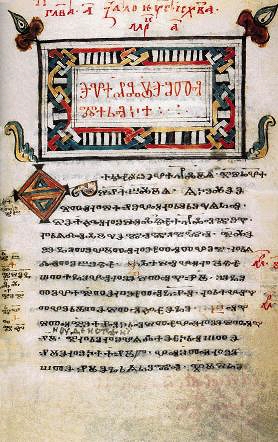The first alphabet, the Glagolitic, was appropriate to express all the sounds of the Slavic language and it corresponded to the phonetic features of different dialects. Constantine-Cyril the Philosopher created an alphabet with 38 letters, i.e. one letter for every sound of the Slavic speech. The Glagolitic alphabet does not resemble any other known alphabet. Research today accepts that this is an original invention. The apparent similarity of the letter-like symbols of the Glagolitic alphabet with the symbols used by the alchemists of that time as well as by other "mystical" and "apocryphal" letters is a source of major controversy.
The Cyrillic alphabet, which is based on the major letters of the Greek alphabet, and does not have even a visual connection with the Glagolitic alphabet, was probably created in the Preslav Literary School in North East Bulgaria. This theory is supported by the fact that the Cyrillic alphabet almost entirely replaced the Glagolitic in this area in the late tenth century, whereas the Ohrid Literary School continued to use the Glagolitic alphabet until the twelfth century. Assuming, as many believe, that the creation of the alphabet represented the greatest achievement of Constantine-Cyril the Philosopher, how should we explain its rapid rejection and replacement?
 One of the reasons for the replacement of the alphabet, which today represents the graphics system used by part of the Slavic world and a lot of Asian nations, is considered its simplification and greater ease of use. I regret, however, when I find that some Slavic peoples, primarily in Central Europe, have sacrificed a rich and well-structured alphabet on the altar of their Latinisation. From glagolica we pass to cirilica and then to latinica. What follows, by the way?
One of the reasons for the replacement of the alphabet, which today represents the graphics system used by part of the Slavic world and a lot of Asian nations, is considered its simplification and greater ease of use. I regret, however, when I find that some Slavic peoples, primarily in Central Europe, have sacrificed a rich and well-structured alphabet on the altar of their Latinisation. From glagolica we pass to cirilica and then to latinica. What follows, by the way?
You have occupied yourself professionally with the talismans and amulets of late antiquity, and especially with the way in which these were preserved and transformed by the first Christian communities. For the year 2016–17, in cooperation with Professor Chirstopher Faraone of the University of Chicago, you are laying the foundations for an international conference on the topic of "Magic Inscribed Stones of Late Antiquity and of the Byzantine Period". Is it your desire to have this conference realized in Thessaloniki, and in particular at the Museum of Byzantine Civilization?
My involvement with the "magical" world of talismans began about 15 years ago and it will continue to command my attention for some time to come. My doctoral thesis, as well as many of my articles and activities, have had as a topic the study and research of amulets, and especially the enduring weakness of mankind in confronting “the two ruling forces of life, Fear and Hope”, as Loukianos aptly formulated it during the second century CE.
This particular conference constitutes an institution, which is realized at regular intervals in different cities of the world. At the London conference of 2006, in which I participated, I had the pleasure to get closely acquainted with all the big names in the scientific field and most importantly to be accepted as one of them. In their singular way, they made me feel "important". I was (and continue to be) the only Greek scholar engaged in studying this specific topic, and moreover with the eyes of a Byzantinologist. Also, I was the youngest of the gathering, something which impelled them to embrace and "adopt" me.
Seven of those leading researchers/scholars/professors also did me the honour of contributing squibs for my currently in-press book ''Phylax (Guard): Amulets in Late Antiquity''. Any time that I want to feel better, I read the prefaces which they have dedicated to me, and I confess that many times I cannot hold back my tears, when I ascertain with how much immediacy, directness and altruism they place me on a level equal to themselves, as when Professor Peter Brown writes "that it concerns a study which we will be having with us for many years!".
As you can understand, we are talking about surrealistic situations for a Greek scholar who has learned that in order to attain the least little thing one first has to give one's all.
Naturally, to attain my wish for the conference as well as for a certain accompanying exhibition, to be realized in Thessaloniki and particularly at the Museum of Byzantine Civilization. Unfortunately, that does not depend on me. Museums in Greece operate as mere public services and the final decisions in each case are strictly the concern of the administrators. The difficulties are not limited to them and their realization, but mainly to the manner in which they will become acceptable to the particular management, which usually is not represented by the most dynamic intellects but by the most trustworthy party-loyal human reserves. Of course, this view of mine is not the whole story. There will always be a chink in all this through which light can enter. There exist and always will exist certain individuals who will choose to take, from the altars of the past, the flame and not the ashes. I rely on them.